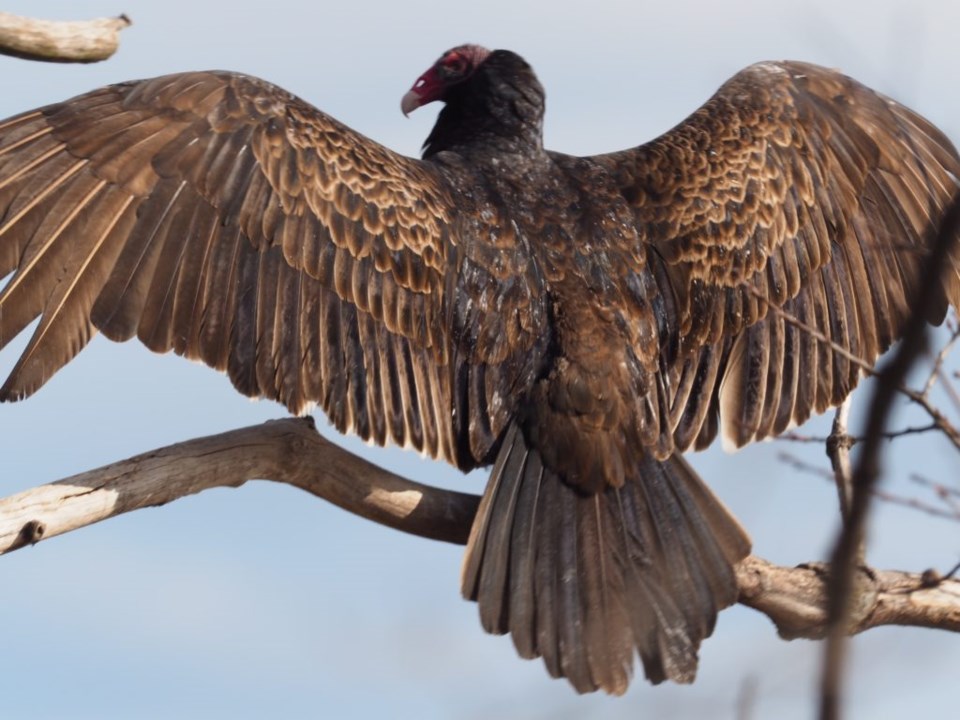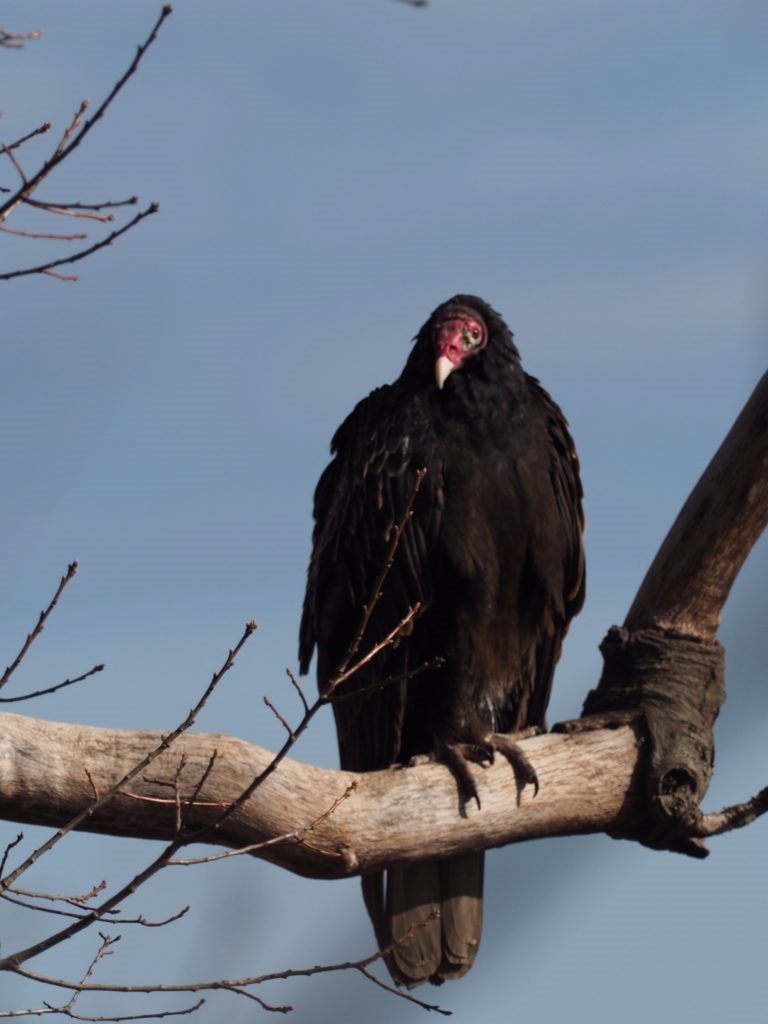
Soaring above the skies of town and surrounding region, many of us have recently admired the large raptors, turkey vultures (Cathartes aura) returning on their spring migration. With a possible wing span of close to two metres, they are easy to spot in the sky, especially on a windy day.
Their flight pattern often seems quite whimsical, shifting and drifting with the wind and the upwellings of warmer air. The ends of their wings resemble ‘fingers’ which makes it easier for us to identify them from the ground. We see them in the spring and fall in larger numbers as they migrate. No problems for them spending the winter in the south and crossing the border with the warmer weather during a pandemic! When a large number of them are spotted in the skies, this is known as ‘kettling,’ and occurs during their spring and fall migrations. They are less likely to be seen in the morning —they tend to wait until the afternoon, when there are stronger air currents and thermals carry them further and faster.
When they fly south, they will travel past the areas in the U.S. where turkey vultures live year round, instead continuing until they get to places such as Venezuela and Argentina.

Despite the fact that the creatures have a face that best could be described as one that only a mother could love, vultures are quite fascinating. They resemble, from a distance, a wild turkey, but have no feathers on their heads. As they have no voice box like other birds, they can only emit a grunting sound or a hiss. The red-faced turkey vulture is the most common species seen in the area, but the black vulture (Coragyps atratus) is being spotted a lot more recently. Two weeks ago a number of the black vultures were spotted in the Queenston area.
I had only known about this species of birds since spotting them occasionally in the skies above Highway 6 and 10 while driving to Tobermory, Ontario, but, despite remarking on their flight and size, never knew too much about them. I can remember driving down the Niagara Parkway a few years ago, and becoming aware of these large creatures sitting on a post in a vineyard. I slowed down, and then realized there were quite a few, just sitting around. I had never actually seen them that close before. Then, two years ago, a large number of them appeared behind a neighbour’s house across the street. I counted about 35 of them roosting in several trees on their property. Upon investigation, we found a dead raccoon in the yard that the vultures were taking turns to devour. Turkey vultures have an amazing sense of smell.
As they drift closer to the ground, they use this sense to detect the presence of carrion. As such, they act as nature’s clean-up crew, and are quite important for that reason. Last summer, while visiting the Lake Erie shoreline at Morgan’s Point, I saw several vultures cleaning up dead fish that had drifted ashore, ending up on the rocky shoreline. Without such animals performing the task of cleaning up, rotting carcasses would be a source of bacteria and disease.
This year, when I started spotting them in the air and seeing some photos posted on Facebook, from other photographers, I once again decided to head down the Niagara Parkway toward Queenston. At first, I was keeping an eye on the fence posts along the way, but no luck.
As I headed up the escarpment at Queenston and rounded the bend, I spotted several sitting in a tree across the roadway. I managed to quickly pull into the laneway on the right, where the steps leading up to Brock’s Monument are located. I parked and slowly climbed out of my vehicle. I eased my camera strap over my head and around my neck before carefully crossing the road. I didn’t want to scare them off. They appeared to be quite uninterested in my presence.
The sun, however, was behind them, making it difficult to get photos that were simply not silhouettes. I did manage a few though. It was on this occasion that I first witnessed one of the four spread its wings and hold them out for an extended period. This is known as the ‘horaltic’ pose. When doing this, the vulture is either drying its wings if they are wet, or regulating its body temperature, trying to cool down or warm up. Another species of bird that can commonly be observed posing in this fashion is the cormorant. I stood fascinated for several minutes when it appeared another one was coming in for a landing. The first four, however, quickly winged up and flew away. The moment had passed!
Looking closer at the new arrival, I noticed that the new vulture was actually a red-tailed hawk. It had landed on the same branch that one of the vultures had so recently occupied. The vultures sure did not wait around long to make introductions with the new arrival.
Returning to the area on another day, I, along with another photographer, found a location that offered an opportunity to photograph a few roosting turkey vultures enjoying the morning sun.
They remained in location for some time before winging up and drifting leisurely over the gorge in search of food, or simply another tree farther away from our lenses.